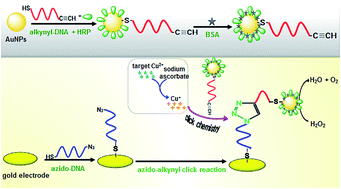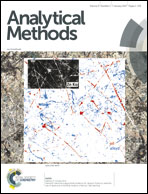Target-induced click conjugation for attomolar electronic monitoring of Cu(ii) using horseradish peroxidase as indicator and nanogold particles as enhancer
Abstract
Herein, a new electrochemical sensing protocol was designed for ultrasensitive detection of copper(II) (Cu2+) at the attomolar level based on target-induced click conjugation using horseradish peroxidase (HRP) as an indicator and gold nanoparticle (AuNP) as an enhancer. The click conjugation was carried out between the immobilized azido-DNA on the electrode and alkynyl-DNA/HRP-labeled AuNP. With the help of sodium ascorbate, target Cu2+ ion was initially reduced into Cu+, and the as-produced Cu+ could catalyze the azide–alkyne click reaction. Accompanying gold nanoparticles, the carried HRP molecules could electrochemically reduce the substrate (H2O2); this resulted in a strong electronic signal. The digital readout was relative to the amount of the peroxidase and indirectly reflected the Cu2+ concentration in the testing media. Under optimal conditions, the as-prepared sensor exhibited good electrochemical response towards Cu2+ in the 1.0 aM to 10 μM dynamic working range with a 0.38 aM detection limit. This methodology also displayed a high selectivity for Cu2+ relative to other potentially interfering ions due to the specific Cu+-induced azide–alkyne click reaction, and was applicable for monitoring Cu2+ in real river samples. Our strategy has a good potential for use in environmental surveys.


 Please wait while we load your content...
Please wait while we load your content...